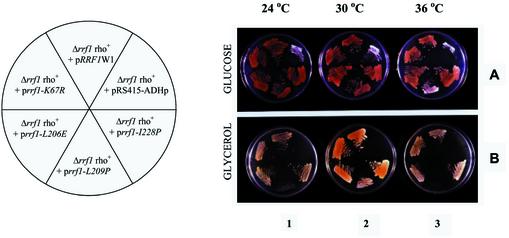Figure 2.
Complementation of Δrrf1 rho+ haploid cells with a plasmid carrying RRF1. Evidence that rrf1-L209P gives temperature-sensitive growth. Δrrf1 rho+ haploid cells harboring various plasmids carrying mutated RRF1 were created as described in Materials and Methods. These various strains are indicated in the circle with the pie cut (left). (A) Cells harboring each of the plasmids as shown in the left panel were streaked onto synthetic glucose (3%) medium lacking leucine and grown at 24, 30 and 36°C. (B) The same strains were grown overnight in synthetic glucose medium minus leucine, streaked onto YPG plates (containing 3% glycerol) and incubated at 24, 30 and 36°C. Δrrf1 rho+ haploid cells (ET2) are ade2-101. Such adenine-deficient cells are known to accumulate red pigments in the presence of low adenine when they are respiratory competent. Note that Δrrf1 rho+ + prrf-L209P could not grow on glycerol at 36°C (lower middle streak, plate 3) while the strain harboring pRS415-ADHp (no RRF1) did not grow in glycerol medium at all temperatures tested (plates 1–3, upper right streak). This indicates that Δrrf1 rho+ + pRS415-ADHp was converted to rho– because of the lack of Rrf1p.

